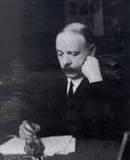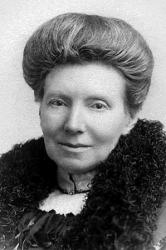Planning worship?
Check out our sister site, ZeteoSearch.org,
for 20+ additional resources related to your search.
- |
User Links
Person Results
William J. Kirkpatrick

1838 - 1921 Person Name: William J. Kirkpatrick, 1838-1921 Scripture: John 20:1-9 Composer of "DUNCANNON" in Worship and Rejoice William J. Kirkpatrick (b. Duncannon, PA, 1838; d. Philadelphia, PA, 1921) received his musical training from his father and several other private teachers. A carpenter by trade, he engaged in the furniture business from 1862 to 1878. He left that profession to dedicate his life to music, serving as music director at Grace Methodist Church in Philadelphia. Kirkpatrick compiled some one hundred gospel song collections; his first, Devotional Melodies (1859), was published when he was only twenty-one years old. Many of these collections were first published by the John Hood Company and later by Kirkpatrick's own Praise Publishing Company, both in Philadelphia.
Bert Polman
William J. Kirkpatrick
Vincent Novello
1781 - 1861 Person Name: Francis Vincent Novello (1781-1861) Scripture: John 20:19-31 Harmonizer (attributed to) of "TANTUM ERGO (ST. THOMAS)" in Common Praise (1998)
Vincent Novello
Charles Wood

1866 - 1926 Person Name: Charles Wood (1866-1926) Scripture: John 20:10-18 Harmonizer of "VRUECHTEN" in Church Hymnary (4th ed.)
Charles Wood
Bessie Porter Head

1850 - 1936 Scripture: John 20:22 Author of "O Breath of Life" in The United Methodist Hymnal [Elizabeth Ann Porter Head]
Head, Elizabeth Ann (`Bessie'; née Porter)
b. Belfast: 1850
d. Wimbledon, Surrey: 28 June 1936
She was the youngest daughter of Tobias Porter, manager of John Alexander's flour mill in Belfast. Of her early life nothing is known; but in 1894 she became secretary of the YWCA in Swansea. She then served with the South Africa General Mission from 1897-1907, mostly in Port Elizabeth, Cape Town and Johannesburg, helping to found several branches of the YWCA.
With the chairman of the Mission and a fellow missionary she toured North America in 1906-7; her intended return to South Africa in November 1907 was cancelled in favour of marriage, on 17 December, to the chairman, Albert Alfred Head (1844-1928), a wealthy - and generous - insurance underwriter who had been widowed three years previously.
With her husband she continued actively to support both the SAGM and the Keswick Convention, with which the mission was closely associated. She was a frequent speaker for both organizations and a prolific contributor, in prose and in verse, to their publications.
A collection of her writings, Heavenly Places, & Other Messages, was published in 1920.
Invariably known as Bessie Porter before her marriage, she later styled herself Bessie Porter Head. After her husband's death in 1928 she moved into the SAGM house in Wimbledon, where she died.
--www.canamus.org/Enchiridion
Bessie Porter Head
William Farley Smith
1941 - 1997 Person Name: William Farley Smith (1941-1997) Scripture: John 20:1-18 Adapter of "He rose, he rose" in Church Hymnary (4th ed.)
William Farley Smith
Orlando Gibbons

1583 - 1625 Scripture: John 20:22 Composer of "SONG 13" in The Worshiping Church Orlando Gibbons (baptised 25 December 1583 – 5 June 1625) was an English composer, virginalist and organist of the late Tudor and early Jacobean periods. He was a leading composer in the England of his day.
Gibbons was born in Cambridge and christened at Oxford the same year – thus appearing in Oxford church records.
Between 1596 and 1598 he sang in the Choir of King's College, Cambridge, where his brother Edward Gibbons (1568–1650), eldest of the four sons of William Gibbons, was master of the choristers. The second brother Ellis Gibbons (1573–1603) was also a promising composer, but died young. Orlando entered the university in 1598 and achieved the degree of Bachelor of Music in 1606. James I appointed him a Gentleman of the Chapel Royal, where he served as an organist from at least 1615 until his death. In 1623 he became senior organist at the Chapel Royal, with Thomas Tomkins as junior organist. He also held positions as keyboard player in the privy chamber of the court of Prince Charles (later King Charles I), and organist at Westminster Abbey. He died at age 41 in Canterbury of apoplexy, and a monument to him was built in Canterbury Cathedral. A suspicion immediately arose that Gibbons had died of the plague, which was rife in England that year. Two physicians who had been present at his death were ordered to make a report, and performed an autopsy, the account of which survives in The National Archives:
We whose names are here underwritten: having been called to give our counsels to Mr. Orlando Gibbons; in the time of his late and sudden sickness, which we found in the beginning lethargical, or a profound sleep; out of which, we could never recover him, neither by inward nor outward medicines, & then instantly he fell in most strong, & sharp convulsions; which did wring his mouth up to his ears, & his eyes were distorted, as though they would have been thrust out of his head & then suddenly he lost both speech, sight and hearing, & so grew apoplectical & lost the whole motion of every part of his body, & so died. Then here upon (his death being so sudden) rumours were cast out that he did die of the plague, whereupon we . . . caused his body to be searched by certain women that were sworn to deliver the truth, who did affirm that they never saw a fairer corpse. Yet notwithstanding we to give full satisfaction to all did cause the skull to be opened in our presence & we carefully viewed the body, which we found also to be very clean without any show or spot of any contagious matter. In the brain we found the whole & sole cause of his sickness namely a great admirable blackness & syderation in the outside of the brain. Within the brain (being opened) there did issue out abundance of water intermixed with blood & this we affirm to be the only cause of his sudden death.
His death was a shock to peers and the suddenness of his passing drew comment more for the haste of his burial – and of its location at Canterbury rather than the body being returned to London. His wife, Elizabeth, died a little over a year later, aged in her mid-30s, leaving Orlando's eldest brother, Edward, to care for the children left orphans by this event. Of these children only the eldest son, Christopher Gibbons, went on to become a musician.
One of the most versatile English composers of his time, Gibbons wrote a quantity of keyboard works, around thirty fantasias for viols, a number of madrigals (the best-known being "The Silver Swan"), and many popular verse anthems. His choral music is distinguished by his complete mastery of counterpoint, combined with his wonderful gift for melody. Perhaps his most well known verse anthem is This is the record of John, which sets an Advent text for solo countertenor or tenor, alternating with full chorus. The soloist is required to demonstrate considerable technical facility at points, and the work at once expresses the rhetorical force of the text, whilst never being demonstrative or bombastic. He also produced two major settings of Evensong, the Short Service and the Second Service. The former includes a beautifully expressive Nunc dimittis, while the latter is an extended composition, combining verse and full sections. Gibbons's full anthems include the expressive O Lord, in thy wrath, and the Ascension Day anthem O clap your hands together for eight voices.
He contributed six pieces to the first printed collection of keyboard music in England, Parthenia (to which he was by far the youngest of the three contributors), published in about 1611. Gibbons's surviving keyboard output comprises some 45 pieces. The polyphonic fantasia and dance forms are the best represented genres. Gibbons's writing exhibits full mastery of three- and four-part counterpoint. Most of the fantasias are complex, multisectional pieces, treating multiple subjects imitatively. Gibbons's approach to melody in both fantasias and dances features a capability for almost limitless development of simple musical ideas, on display in works such as Pavane in D minor and Lord Salisbury's Pavan and Galliard.
In the 20th century, the Canadian pianist Glenn Gould championed Gibbons's music, and named him as his favorite composer. Gould wrote of Gibbons's hymns and anthems: "ever since my teen-age years this music ... has moved me more deeply than any other sound experience I can think of." In one interview, Gould compared Gibbons to Beethoven and Webern:
...despite the requisite quota of scales and shakes in such half-hearted virtuoso vehicles as the Salisbury Galliard, one is never quite able to counter the impression of music of supreme beauty that lacks its ideal means of reproduction. Like Beethoven in his last quartets, or Webern at almost any time, Gibbons is an artist of such intractable commitment that, in the keyboard field, at least, his works work better in one's memory, or on paper, than they ever can through the intercession of a sounding-board.
To this day, Gibbons's obit service is commemorated every year in King's College Chapel, Cambridge.
--wikipedia.org
Orlando Gibbons
Alfred V. Fedak
b. 1953 Person Name: Alfred V. Fedak, 1953- Scripture: John 20:1 Composer of "NEW DISCIPLES" in Worship and Rejoice Alfred Fedak (b. 1953), is a well-known organist, composer, and Minister of Music at Westminster Presbyterian Church on Capitol Hill in Albany, New York. He graduated from Hope College in 1975 with degrees in organ performance and music history. He obtained a Master’s degree in organ performance from Montclair State University, and has also studied at Westminster Choir College, Eastman School of Music, the Institute for European Studies in Vienna, and at the first Cambridge Choral Studies Seminar at Clare College, Cambridge.
As a composer, he has over 200 choral and organ works in print, and has three published anthologies of his work (Selah Publishing). In 1995, he was named a Visiting Fellow in Church Music at Episcopal Seminary of the Soutwest in Austin, Texas. He is also a Fellow of the American Guild of Organists, and was awarded the AGO’s prestigious S. Lewis Elmer Award. Fedak is a Life Member of the Hymn Society, and writes for The American Organist, The Hymn, Reformed Worship, and Music and Worship. He was a member of the Presbyterian Committee on Congregational Song that prepared Glory to God, the 2013 hymnal of the Presbyterian Church (U.S.A.)
Laura de Jong
Alfred V. Fedak
Ronald Arnatt
1930 - 2018 Person Name: Ronald Kent Arnatt (b. 1930) Scripture: John 20:19 Composer of "LADUE CHAPEL" in Church Hymnary (4th ed.)
Ronald Arnatt
J. R. Peacey
1896 - 1971 Person Name: J. R. Peacey, 1896-1971 Scripture: John 20:19-31 Author of "Dear Lord, We Long to See Your Face" in Common Praise (1998)
J. R. Peacey
Reginald Sparshatt Thatcher
1888 - 1957 Person Name: Reginald S. Thatcher, 1888-1957 Scripture: John 20:1-9 Composer of "NORTHBROOK" in Gather Comprehensive
Reginald Sparshatt Thatcher


 My Starred Hymns
My Starred Hymns


